ColecoVision
 | |
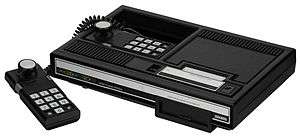 | |
| Manufacturer | Coleco |
|---|---|
| Type | Home video game console |
| Generation | Second generation |
| Retail availability |
‹See Tfd›
‹See Tfd›
|
| Discontinued | 1985 |
| Units sold | 2+ million |
| Media | ROM cartridge |
| CPU | Zilog Z80 |
| Storage | 8/16/24/32 KB |
| Graphics | TMS9928A |
| Controller input |
Joystick/Numeric Keypad Roller Controller Driving Controller Super Action Controller |
| Best-selling game | Donkey Kong (pack-in) |
| Predecessor | Telstar series (1978) |
The ColecoVision is Coleco Industries' second-generation home video-game console which was released in August 1982. The ColecoVision offered a closer experience to more powerful arcade game systems compared to competitors such as the Atari 2600, along with the means to expand the system's basic hardware.
The initial catalog of twelve games included Nintendo's Donkey Kong as the pack-in cartridge, Sega's graphically impressive Zaxxon, and some lesser known arcade titles that found a larger audience on the console, such as Lady Bug, Cosmic Avenger, and Venture. Approximately 145 titles in total were published as ROM cartridges for the system between 1982 and 1984.[1]
Coleco withdrew from the video game market in 1985, and ColecoVision was discontinued that same year. River West Brands currently owns the ColecoVision brand name.[2]
History
By Christmas of 1982, Coleco had sold more than 500,000 units,[3][4] in part on the strength of its bundled game.[5] The ColecoVision's main competitor was the arguably more advanced but less commercially successful Atari 5200.[6][7][8]
The ColecoVision was distributed by CBS Electronics outside of North America, and was branded the CBS ColecoVision.
Sales quickly passed 1 million in early 1983,[9] before the video game crash of 1983. By the beginning of 1984, quarterly sales of the ColecoVision had dramatically decreased.[10]
Over the next 18 months, the Coleco company ramped down its video game division, ultimately withdrawing from the video game market by the end of the summer of 1985.[11][12] The ColecoVision was officially discontinued by October 1985.[13] Total sales of the ColecoVision are uncertain but were ultimately in excess of 2 million units, as sales had reached that number by the spring of 1984,[10] while the console continued to sell modestly up until its discontinuation the following year.[14]
In 1983 Spectravideo announced the SV-603 ColecoVision Video Game Adapter for its SV-318 computer. The company stated that the $70 product allowed users to "enjoy the entire library of exciting ColecoVision video-game cartridges".[15] In 1986, Bit Corporation produced a ColecoVision clone called the Dina, which was sold in the United States by Telegames as the Telegames Personal Arcade.[16]
Hardware
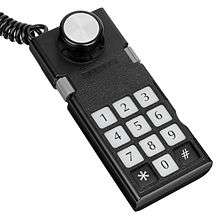
The main console unit consists of a 14×8×2-inch rectangular plastic case that houses the motherboard, with a cartridge slot on the right side and connectors for the external power supply and RF jack at the rear. The controllers connect into plugs in a recessed area on the top of the unit.
The design of the controllers is similar to that of Mattel's Intellivision—the controller is rectangular and consists of a numeric keypad and a set of side buttons. In place of the circular control disc below the keypad, the Coleco controller has a short, 1.5-inch joystick. The keypad is designed to accept a thin plastic overlay that maps the keys for a particular game. Each ColecoVision console shipped with two controllers.
All first-party cartridges and most third-party software titles feature a 12-second pause before presenting the game select screen.[17] This delay results from an intentional loop in the console's BIOS to enable on-screen display of the ColecoVision brand. Companies like Parker Brothers, Activision, and Micro Fun bypassed this loop, which necessitated embedding portions of the BIOS outside the delay loop, further reducing storage available to actual game programming.
Technical specifications

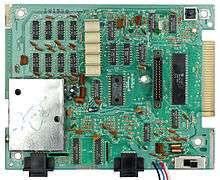
- CPU: NEC version of Zilog Z80A @ 3.58 MHz (See chip U1, marked NEC D780C-1 in circuit board picture)
- Video processor: Texas Instruments TMS9928A (40-pin DIP located under the heat sink)
- 256×192 pixel resolution
- 32 sprites on-screen at once
- 16 colors
- Sound: Texas Instruments SN76489A PSG (chip U20 on circuit board)
- 3 tone generators
- 1 noise generator
- Video RAM: 16 KB (as eight 16K x 1-bit chips, marked ITT 8244 4116 3N on circuit board)
- RAM: 1 KB (as two 1K x 4-bit chips, marked UPD2114LC (U3 & U4) on circuit board)
- ROM: 8 KB Texas Instruments TMS4764 Mask ROM (chip U2, marked TMS4764NL on circuit board)
- Storage: ROM Cartridge of 8, 16, 24 or 32 KB capacity.
Expansion Modules and accessories
From its introduction, Coleco touted the ColecoVision's hardware expandability by highlighting the Expansion Module Interface on the front of the unit. These hardware expansion modules and accessories were sold separately.
Released
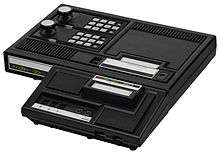
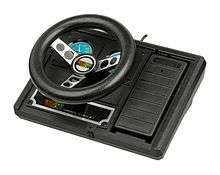
- Expansion Module #1 makes the ColecoVision compatible with the industry-leading Atari 2600, with some exceptions.[17] Functionally, this gave the ColecoVision the largest software library of any console of its day. The expansion module prompted legal action from Atari, but Atari was unable to stop sales of the module because the 2600 could be reproduced with off the shelf parts. Coleco also designed and sold the Gemini game system, which was a clone of the 2600, but with combined joystick/paddle controllers.
- Expansion Module #2 is a driving controller (steering wheel / gas pedal) that came packaged with a port of the arcade game Turbo. The gas pedal is merely a simple on/off switch, so many gamers used the second ColecoVision controller as a gear shift for more precise speed control.[18] Although Coleco called the driving controller an expansion module, it actually plugs into the controller port, not the Expansion Module Interface.[19] The driving controller is also compatible with the games Destructor, Bump 'n' Jump, Pitstop, and The Dukes of Hazzard.
- Expansion Module #3 converts the ColecoVision into a full-fledged computer known as the Adam, complete with keyboard, digital data pack (DDP) cassette drives and printer.
- The Roller Controller is a trackball that came packaged with a port of the arcade game Slither, a Centipede clone.[20][21] The roller controller uses a special power connector which is not compatible with Expansion Module #3 (the Adam computer). Coleco mailed an adapter to owners of both units who complained.[22] The roller controller is also compatible with the games Victory, Omega Race, and Wargames, and was also compatible with Atarisoft's port of Centipede, which used a trackball for arcade play.
- The Super Action Controller Set is a set of two joysticks (each resembling a boxing glove) that came packaged with the game Super Action Baseball. Each joystick has four action buttons, a 12-button numeric keypad, and a "speed roller".[23] The Super Action Controllers are also compatible with the games Super Action Football, Rocky Super Action Boxing, and a port of the arcade game Front Line.
Games
Legacy
In 2009, IGN named the ColecoVision their 12th-best video-game console out of their list of 25, citing "its incredible accuracy in bringing current-generation arcade hits home."[24]
In 1996, programmer Kevin Horton released the first homebrew game for the ColecoVision, a Tetris clone entitled Kevtris.[25][26]
In 1997, Telegames released Personal Arcade Vol. 1, a collection of ColecoVision games for Microsoft Windows,[27] and a 1998 follow-up, Colecovision Hits Volume One.[28]
In 2014, AtGames began producing the ColecoVision Flashback. It was released on October 7, 2016 on Steam.[29]
References
- ↑ Forster, Winnie (2005), The encyclopedia of consoles, handhelds & home computers 1972 - 2005, GAMEPLAN, p. 50, ISBN 3-00-015359-4
- ↑ "Press release for River West Brands" (PDF). Retrieved 2010-12-20.
- ↑ "Coleco hits with home video games", Business Week: 31, 1983-01-24,
Most of 1982's action was in the second half, when Coleco shipped 550,000 ColecoVision game machines--which sell for $169 to $189--booking orders for nearly that many more.
- ↑ Video Game Maker Says 1st-Quarter Profit More Than Tripled, Associated Press, 1983-04-20,
Arnold C. Greenberg, Coleco's president and chief executive, said more than 500,000 ColecoVision players were shipped during the first quarter, nearly equaling the number shipped in all of 1982.
- ↑ "Coleco's New Video Challenge", New York Times: 1 (Section D), 1982-11-11,
Potential Colecovision buyers have also apparently been attracted by Coleco's licensing agreement with Nintendo Inc., the Japanese creator of Donkey Kong, a current arcade hit, and Universal City Studios Inc. One Donkey Kong cartridge comes with each Colecovision unit.
- ↑ Aeppel, Timothy (1982-12-10), "Zap! Pow! Video games sparkle in holiday market", Christian Science Monitor: 7,
In recent weeks, two particularly hot-selling systems have emerged - the Atari 5200 and ColecoVision. Both are described as powerful 'third wave' machines, the Cadillacs of game systems, and priced accordingly at close to $200...[T]hey are sure to snatch most of the Christmas market.
- ↑ Harmetz, Aljean (1984-01-10), "Sigh of Relief on Video Games", New York Times: 1 (Section D),
As for game hardware, many experts said that Atari's...5200 or Coleco's Colecovision would corner the high end.
- ↑ "Coleco Strong In Marketing", New York Times, 1983-08-01,
Since its introduction last fall, Colecovision has sold about 1.4 million units...Of that total, about 900,000 were sold this year, compared with 800,000 units by Atari and 300,000 by Mattel.
- ↑ Video Game Maker Says 1st-Quarter Profit More Than Tripled, 1983-04-20
- 1 2 Coleco Industries sales report, PR Newswire, 1984-04-17,
'First quarter sales of ColecoVision were substantial, although much less that [sic] those for the year ago quarter,' Greenberg said in a prepared statement. He said the company has sold 2 million ColecoVision games since its introduction in 1982.
- ↑ "Coleco Reassesses Its Video Games", New York Times, Reuters: 4 (Section D), 1985-06-13,
Coleco Industries is assessing its continuing commitment to the video game business...Arnold C. Greenberg, the chief executive, said no timetable had been set for a decision on continuing or dropping the Colecovision products or on whether the software for the games would continue to be produced if hardware production was discontinued.
- ↑ "Video games Coleco may drop out", The Globe and Mail (Canada), 1985-06-21,
Coleco Industries Inc. of West Hartford, Conn., is considering withdrawal from the video game business in both hardware and software.
- ↑ "Coleco's Net In Sharp Rise", New York Times, Associated Press, 1985-10-19,
Thursday, Coleco said the entire inventory of its troubled Adam personal computer has been sold, along with much of its Colecovision inventory. The company's chairman, Arnold Greenberg, said Coleco expects no more charges against earnings from the two discontinued products.
- ↑ Kleinfield, N. R. (1985-07-21), "Coleco Moves Out Of The Cabbage Patch", New York Times: 4 (Section 3),
Coleco is now debating whether to withdraw from electronics altogether. Colecovision still sells, but it is a shadow of its former self.
- ↑ "Heavy Hardware". Softline. March 1983. p. 46. Retrieved 28 July 2014.
- ↑ "ColecoVision - 1982-1984 - Classic Gaming". Classicgaming.gamespy.com. Retrieved 2010-12-20.
- 1 2 The Game Doctor (June 1983). "Q&A". Electronic Games. p. 112. Retrieved 7 January 2015.
- ↑ "Coleco ColecoVision Expansion Module No. 2 Driving Controller Disassembled". The-liberator.net. Retrieved 2014-05-27.
- ↑ http://www.colecovisionzone.com/photos/accessory/module2%20manual.pdf
- ↑ "Controller Update: Probing the World of the Exotic". Electronic Games. June 1983. pp. 24–28. Retrieved 6 January 2015.
- ↑ Classic Game Room reviews COLECOVISION ROLLER CONTROLLER (YouTube) (YouTube). Lord Karnage. 2008. Event occurs at 4:45. Retrieved April 2, 2014.
- ↑ http://www.colecovisionzone.com/photos/accessory/roller%20manual.pdf
- ↑ http://www.colecovisionzone.com/photos/accessory/superaction%20manual.pdf
- ↑ "Colecovision is number 12". IGN. Retrieved 2010-12-20.
- ↑ "Kevtris for ColecoVision". MobyGames. 2006-11-29. Retrieved 2009-08-24.
- ↑ "Classic Videogame Games INTERVIEW - Kevin Horton". Good Deal Games. Retrieved 2009-08-24.
- ↑ "Personal Arcade Volume One for Windows". MobyGames. 2000-05-21. Retrieved 2009-08-24.
- ↑ "Classic Gamer: Colecovision Hits Volume One for Windows". MobyGames. 2000-05-30. Retrieved 2009-08-24.
- ↑ ."ColecoVision Flashback at AtGames E-Store".
External links
| Wikimedia Commons has media related to ColecoVision. |